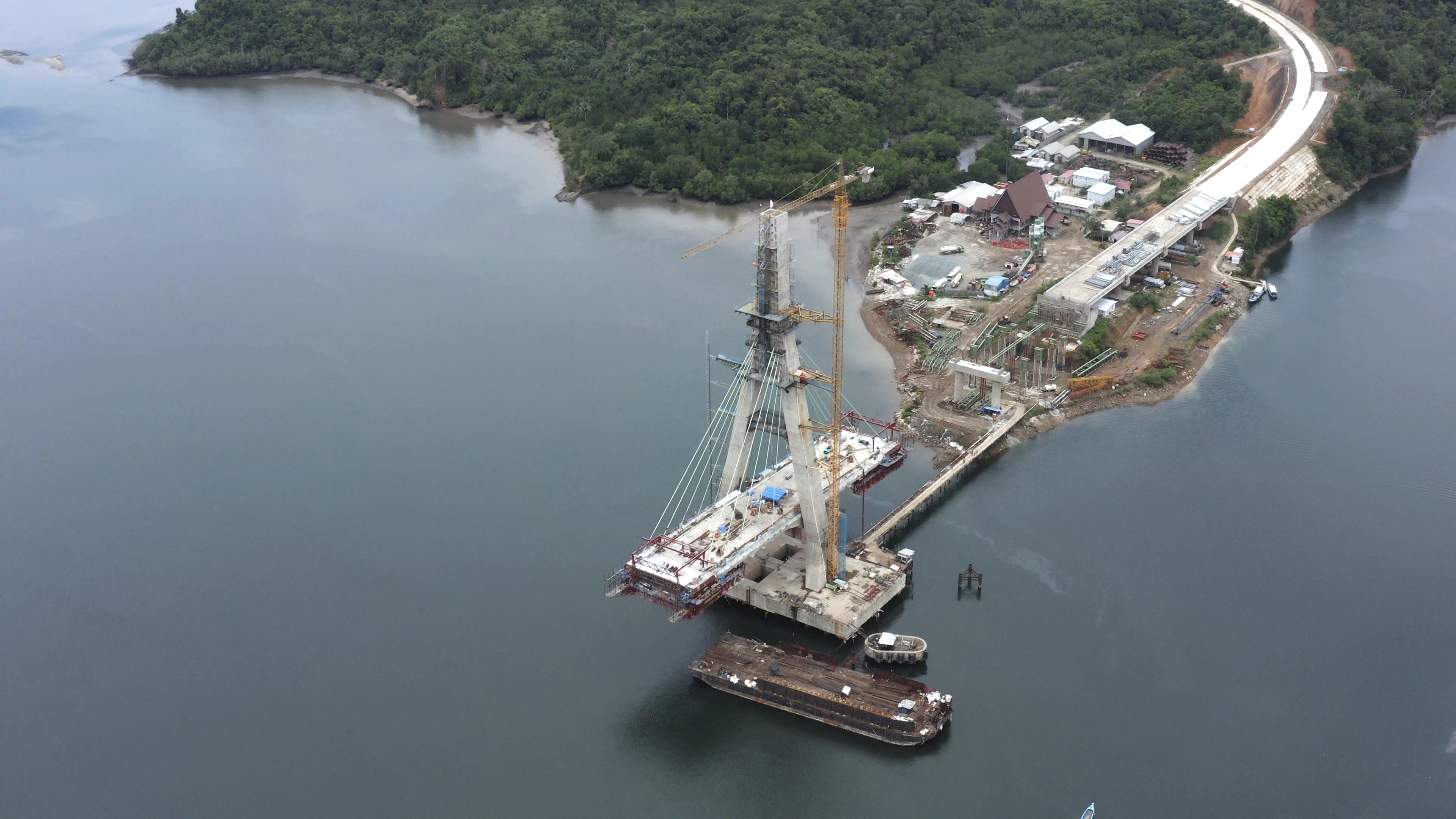Anna Tsing, “Natural Resources and Capitalist Frontiers,” Economic and Political Weekly 38, no. 48 (2003): 5101.
“Series 1: Southeast Asia, Jakarta the MegaCity,” Equator from the Air, BBC2, June 9, 2019, ➝.
Naomi Klein, The Shock Doctrine: The Rise of Disaster Capitalism (Toronto: Knopf Canada, 2007).
Indonesian Ministry of Economic Affairs, Government of the Netherlands, Master Plan. National Capital Integrated Coastal Development, December 1, 2014, 39.
Ibid., 37.
Even the logo developed for the NCICD depicts the significance of real estate in the project, focusing on a new skyline of high-rise buildings without any reference to flood adaptation.
Rijksoverheid, Internationale Waterambitie, January 2016, 11, ➝.
See, for example, “Boskalis and Van Oord to construct artificial island off the coast of Jakarta, Indonesia”, Dutch Water Sector, January 29, 2015, ➝.
On threat as virtual futurity affecting the present, see Brian Massumi, “Fear (the Spectrum Said)”, positions 13.1 (2005): 31–48.
Philip Sherwell, “$40bn to save Jakarta: The story of the Great Garuda,” The Guardian, November 22, 2016, ➝.
See for example: A. Muh. Ibnu Aqil, “Jokowi’s approval of Jakarta islet development stokes criticism”, The Jakarta Post, May 18, 2020, ➝; “Anies Beber Alasan Tak Cabut Pergub Ahok Dasar IMB Reklamasi”, CNN Indonesia, June 19, 2019, ➝; “Ahok says he was ‘scapegoated’ after governor Anies issued building permits on controversioal reclaimed Jakarta Bay islets”, Coconuts Jakarta, June 20, 2019, ➝.
Interview with coastal residents, January 10, 2020; see also Vela Andapita and Sausan Atika, “‘It was scary’: Wall collapse raises concerns about coastal safety in Jakarta,” The Jakarta Post, December 7, 2019, ➝.
Much of the research about the sea wall and the new Indonesian capital was conducted with Etienne Turpin for our forthcoming film Tidak Ada Kapital (There is No Capital). On processes of accumulation and abandonment, see: Nashin Mahtani and Etienne Turpin, “There is No Capital,” Kerb 28 (Fall 2020).
N. Adri, “Wanted: Designs for Indonesia’s new smart, green capital city”, The Jakarta Post, October 3, 2019, ➝.
Secretariat of the National Capital Infrastructure Development Planning Task Force, “A contest for the design of the nation's capital region,” Ministry of Public Works and Public Housing of Republic of Indonesia, 2019, ➝.
On the eurocentric geopolitics of industrialized war and capitalism that produced this ecocide, see Jarius Grove, Savage Ecology: War and Geopolitics at the End of the World (Durham and London: Duke University Press, 2019).
In late June 2020, the ministry of public works and housing announced that construction would continue on schedule; separately, the national planning agency suggested that activities would be delayed; other senior administrators overseeing the project have refused to comment on its schedule.
Marchio Irfan Gorbiano, “Jokowi welcomes Kalimantan’s first toll road, seeks link to new capital,” The Jakarta Post, December 18, 2019, ➝.
On the importance of peatland ecologies for slowing climate change, see Peta Bencana, “Peat Fires & Palm Oil: An Introduction by PetaBencana.id,” YouTube, November 18, 2017, ➝.
Fabiola Fabrianti, “Antisipasi Spekulasi Tanah di Kaltim, ATR/BPN akan Lakukan Land Freezing”, Suara.com, August 28, 2019, ➝.
Under the law, any land that cannot be proven to be owned by anyone is automatically property of the state. For decades, Indigenous communities in Indonesia (especially in rural areas) have been displaced because they do not have (and usually cannot acquire) the documentation to prove their inheritance of land that has been cultivated and passed on over many generations.
“RUU Pertanahan Dinilai Memuat Belasan Pasal Bermasalah,” CNN Indonesia, September 7, 2019, ➝.
Although details are still to be determined, the scheme is modelled on the Land Swap Agreement enacted in 2016, when in the aftermath of the environmental destruction caused by the unprecedented 2015 forest fires, the government designated five million acres of land as a priority peatland restoration zone. Companies already operating in the newly-designated protection areas were offered “replacement” lands, most of which are located in untouched forests of Papua New Guinea.
Fred Moten, Stolen Life: consent not to be a single being (Durham and London: Duke University Press, 2018), 186.
AbdouMaliq Simone, “Urbanity and generic blackness,” Theory, Culture & Society 33, nos. 7–8 (2016): 194.
Jakarta was built on a swampland, so seasonal flooding has always been part of daily life. Early twentieth century literary and popular representations depict the flood not as a threat, but as a festive event. For more on the shifting framing of flooding, see “Urban temporalities—Jakarta after the new order: Abidin Kusno in conversation with Meredith Miller and Etienne Turpin," Scapegoat: Architecture, Landscape, Political Economy 5 (2013): 180–205. For more on the history of flooding in Jakarta, see Frank Sedlar, “Inundated infrastructure: Jakarta’s failing hydraulic infrastructure," Michigan Journal of Sustainability 4 (2016).
Interview with riverside resident, Sude, April 25, 2018.
PetaBencana.id is a community-led disaster-mapping platform co-founded by Dr. Etienne Turpin and Dr. Tomas Holderness; I am currently the director of Yayasan Peta Bencana (Disaster Map Foundation), which acts as the custodian of the platform and its advocate and manager with partner organizations and communities. For a detailed description of the project, see Nashin Mahtani, “Impressions of Disaster,” e-flux architecture, 2017, ➝.
AbdouMaliq Simone, Jakarta: Drawing the City Near (Minneapolis and London: University of Minnesota Press, 2014), 214.
Anna Tsing, “Contaminated Diversity,” in “Slow Disturbance: Potential Collaborators for a Liveable Earth,” RCC Perspectives 9 (2012): 98.
On the speculative time complex, see Suhail Malik and Armen Avanessian, The Time Complex: Post-Contemporary (Miami: NAME, 2016).
For a speculative inquiry into these questions, see MERA by Strelka—The New Normal, ➝. MERA posits a model of more-than-human environmental co-governance through an inversion of the risk model.
Special thanks to Etienne Turpin for his careful edits on this text, and the continued guidance, discussions, and collaborations that this essay, and the work that it draws from, wouldn’t be possible without. Thanks also to the MERA team for thoughtful collaborations on what it means to think the future differently, and to all colleagues and residents involved in the PetaBencana platform for thinking and working through torrential urbanisms together.
